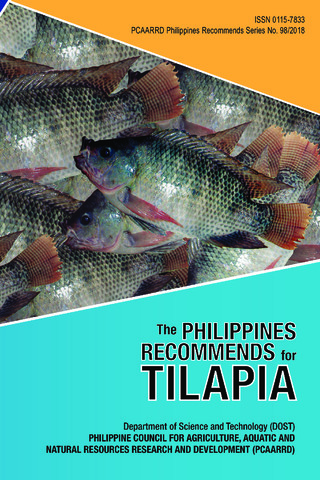Aeromonas load and species composition in tilapia (Oreochromis niloticus) cultured in earthen ponds in the Philippines
- Global styles
- MLA
- Vancouver
- Elsevier - Harvard
- APA
- Help

View/
Date
2020-04-14Page views
3,529ASFA keyword
AGROVOC keyword
Metadata
Show full item record
Share
Abstract
Aeromonas load and species composition in the rearing water, sediment, gills and intestines of healthy tilapia Oreochromis niloticus collected every 2 weeks from Days 30 to 120 after stocking in six earthen ponds in the Philippines were determined. Presumptive Aeromonas counts (PACs) in the water and sediment ranged from 101–103 c.f.u./ml and 101–103 c.f.u./g while in the gills and intestines, PACs ranged from 104–107 c.f.u./g and 102–105 c.f.u./g, respectively. Presumptive Aeromonas counts in the water, sediment, and gills of tilapia varied among days of culture while in the intestines of tilapia, PACs markedly dropped by approximately 2 logs at Day 75 and either remained in the same level or decreased by another 1 log at Day 120 of grow‐out culture. Aeromonas hydrophila predominantly constituted 94% of all presumptive Aeromonas spp. examined (n = 343), followed by A. sobria (4%) and A. salmonicida (2%). Taken together, current data provide some putative threshold levels of tilapia reared in earthen ponds to Aeromonas spp. The dominance of A. hydrophila together with negligible population of A. salmonicida and A. sobria indicate that Aeromonas are common commensal bacteria in tilapia and their environment which under conditions of stress could instigate disease epizootics.
Suggested Citation
Pakingking, R. V., Jr., Palma, P., & Usero, R. (2020). Aeromonas load and species composition in tilapia (Oreochromis niloticus) cultured in earthen ponds in the Philippines. Aquaculture Research , 51(11), 4736-4747. https://doi.org/10.1111/are.14820
Type
ArticleISSN
1355-557X; 1365-2109Collections
- Journal Articles [1258]
Related items
Showing items related by title, author, creator and subject.
-
Vibrio load and percentage composition of sucrose‐fermenting vibrios in Nile tilapia (Oreochromis niloticus) cultured in brackish water earthen ponds and biocontrol potential of recycled tilapia‐conditioned greenwater against population growth of V. parahaemolyticus and non‐sucrose‐fermenting vibrios in the grow‐out culture of white leg shrimp (Litopenaeus vannamei)
Pakingking, Rolando V., Jr. ; Palma, Peter
; Palma, Peter  ; de Jesus-Ayson, Evelyn Grace T.; Usero, Roselyn
; de Jesus-Ayson, Evelyn Grace T.; Usero, Roselyn  (Wiley, 2022-10-20)
Vibrio are known opportunistic pathogens of pond-cultured fish and shrimp. This study determined the presumptive Vibrio count (PVC) and percentage composition of “beneficial” sucrose-fermenting vibrios (SFVs) ...
(Wiley, 2022-10-20)
Vibrio are known opportunistic pathogens of pond-cultured fish and shrimp. This study determined the presumptive Vibrio count (PVC) and percentage composition of “beneficial” sucrose-fermenting vibrios (SFVs) ... -
Series: Philippines Recommends Series; No. 98/2018
The Philippines recommends for tilapia
The Tilapia Technical Committee 2017 (DOST-PCAARRD, 2018)Tilapia is one of the most commercially important commodities in fisheries and aquaculture. Although tilapia is relatively easy to propagate and culture, the Philippine tilapia industry needs the necessary boost in the ... -
Quantitative and qualitative analyses of the bacterial microbiota of tilapia (Oreochromis niloticus) cultured in earthen ponds in the Philippines
The quantity and composition of the bacterial microbiota in the rearing water, sediment, gills and intestines of tilapia Oreochromis niloticus collected every 2 weeks from Day 30 to Day 120 after stocking for grow-out ...




